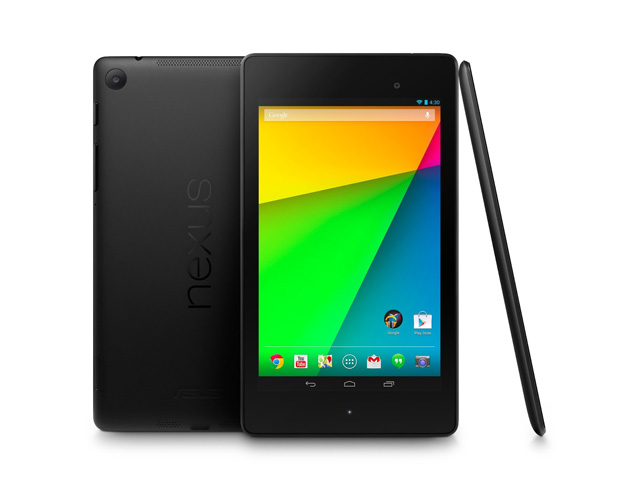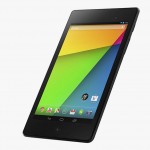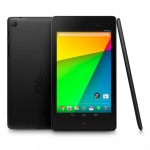preview Google has announced a second generation of its flagship seven inch tablet, the Nexus 7. Its predecessor proved a hit in Australia and helped Android finally succeed in challenging Apple’s dominance in the tablet sector. But will the new 2013 version of the Nexus 7 be a hit or a failure? Read on to find out.
Note: This article represents an advanced look at the design, features and likely performance of this product, but we haven’t actually tested or played with it extensively ourselves it yet. A follow-up full review will be published when we have.
Design
The design of the previous Nexus 7 was one of the aspects of the device which we liked the most (see Delimiter’s review here). It was light enough, thin enough and small enough to hold in one hand, yet had a velvety leathery back which made it eminently grippable in a way that the iPad mini, the Nexus 7’s closest competitor, just never had.
The design of the new Nexus 7 follows this same scheme, but it looks as though Google has improved the tablet even further. You get a similar leathery, grippy dark grey/black back cover for the tablet, but it looks a great deal more classy. The same buttons (volume, on/off) are in the same places on the left-hand side of the tablet, but they also look a little more refined.
The new Nexus 7 is a little bit lighter than the old (290g versus 340g), and it’s also a little thinner, at 8.65mm compared with 10.45mm. It’s also a little taller, at 200mm compared with 198.5mm, and a little shorter length-wise (if you’re holding the tablet vertically) at 114mm compared with 120mm. Overall, we really like the improvements to the tablet’s size and weight — we think they will make it even easier to hold and use an already very comfortable tablet in one hand, with the other used for navigation.
The last thing which you really need to be aware of when it comes to the new Nexus 7’s design is it multimedia capabilities. The screen resolution of the tablet has been bumped up dramatically (to 1920×1200) compared with the old model’s 1280×800, giving the new Nexus 7 one of the highest resolution screens on the market at 323 pixels per inch. It’s also gotten a new pair of in-built stereo speakers. What this means is that Google has been able to substantially beef up the main design element of the Nexus 7 — its screen — as well as integrating what we expect to be much better sound capabilities.
Features
Many areas of the new Nexus 7 have been improved, when it comes to its featureset. We’ve already mentioned its new screen and stereo speakers. In our view, these are almost reason in themselves to upgrade, with the new screen resolution likely making the Nexus 7’s screen one of the best on the market for any tablet, bar none. Great speakers are also rapidly becoming a necessity in any modern tablet, given how much we all use them for consuming multimedia (for me, it’s YouTube videos of Dark Souls PvP matches, while lying on the couch). Google says the new speakers deliver “surround sound” by German research group Fraunhofer.
There’s also a new five megapixel camera on the back of the new Nexus 7 (the old model had no rear-facing camera). The new CPU is a beastly Qualcomm Snapdragon S4 Pro running at 1.5GHz, and an Adreno 320 graphics chip running at 400Mhz is also on-board. You also get the latest version 4.3 of Android, although previous Nexus 7 devices are also upgradable to this version from 4.2, so that’s not a huge exclusive feature.
Apart from these upgrades, much of the rest of the new Nexus 7’s features are similar to those of the old Nexus 7. You get a battery of about the same size, dual-band Wi-Fi (2.4Ghz/5Ghz) up to 802.11n, NFC, Bluetooth 4.0, wireless charging, a microUSB port, 3.5mm audio, an in-built microphone, GPS, gyroscope, accelerometer, compass and ambient light sensors, and support for 4G mobile broadband is optional, including the 1800Mhz band primarily used in Australia. 2GB of RAM is up from 1GB of RAM in the previous model, and you can again get 16GB or 32GB of on-board storage.
What we see in general from the new Nexus 7 in terms of its featureset is that it really brings the model up to date in terms of the wider market, and pushes the bar further out in some areas, such as its screen. Of course, a lot of the ‘secret sauce’ in tablets these days is not in feature lists per se — but relates more to the design and software integration of the devices. Android tablets have been around for some time with high-end features — but it wasn’t really until Google’s highly cohesive and inexpensive Nexus line came around that they started gaining ground on the iPad. We expect to see more of the same from the new Nexus 7.
Performance
It’s hard to predict the performance of a device ahead of time, when we haven’t tested it, but we can already make a few guesses at some aspects of the Nexus 7’s strengths and weaknesses.
For starters, its five megapixel rear-facing camera isn’t going to be great; neither is its front-facing 1.2 megapixel camera. There are just better options out there, and we expect to see vastly improved cameras on the upcoming refreshed Apple iPads which will no doubt be out later this year. In addition, it is very likely that any tablet with a screen as high-resolution as the new Nexus 7’s, with its support for 4G speeds, is going to struggle occasionally with battery life.
However, in general, given the very strong performance of the old Nexus 7, we do expect the new Nexus 7 to be among the best-performing tablets on the market. This theory is supported by early reviews of the device. For example, The Verge tells us:
“There are plenty of people for whom the iPad mini is definitely the right tablet. But before you pick, look through the Play Store and see if you can find everything you need. Because outside of that discrepancy, the Nexus 7 is a better tablet than the iPad mini. It’s so comfortable in one hand, the screen is incredible, and its performance is virtually flawless.”
“As long as you don’t mind the selection of tablet-optimized apps in the Play Store, you’d have to be an extreme power user to not enjoy the latest Nexus 7, and you’d most definitely be paying through the nose to land anything better.”
Conclusion
Google got itself easily to second base with the initial launch of the Nexus 7 last year, and it looks as though its upgraded model will take it all the way with a home run. With new cameras, one of the best tablet screens on the market, better speakers, and a thinner and lighter build, this is one tablet which looks to be a sensational buy. And to boot, we expect the upgraded model’s pricing to start at less than $300 in the Australian market, just like the old one.
If you’re an Android tablet fan and you like the seven inch form factor, this is very likely going to be an instant purchase for you. Start thinking about selling your old model and upgrading. If you have an existing iPad model, and it’s not a recent one, you may also want to think about upgrading, or at least keeping the new Nexus 7 on your list until we find out what Apple has planned for later this year. Android is getting very good, and the Nexus line is also very good. Right now, we’re putting the Nexus line in general at least on par with Apple’s iPads for most uses.
It’s hard to say definitely right now, without a review unit, but on paper the new Nexus 7 is looking like a winner. Stay tuned for an Australian launch shortly.
Image credit: Google





I love my (old model) Nexus 7. For me it is the perfect compromise between size and portability and is good enough to browse, write/read emails, play a few games and use as a storage device (with a workaround). The new Nexus 7 looks fantastic, but not enough to make me buy one to replace my older one.
There appear to be some issues with the new Nexus 7 around its GPS and multi-touch.
http://www.trustedreviews.com/news/new-nexus-7-2-users-report-gps-problems
http://www.trustedreviews.com/news/nexus-7-2-users-report-multitouch-issues-alongside-gps-problems
I am hoping they are software issues and will be rectified soon :( I was hoping to get an upgrade to my current Nexus 7…
If you do a proper review, it’d be nice to compare battery life of the revised model vs the original N7 updated to 4.3, to see whether the extra battery life is solely from the optimised radio usage.
So when will you be giving one away to your esteemed readers?
Hehe I’ll think about it ;)
Promotion for D2 Perhaps?
You mean, if people sign up, they go into the draw to win a Nexus 7? Interesting idea … I hadn’t thought about that. Do you think it would attract many people to sign up?
Would not hurt and if they like it they may stick around!
@Renai: The original Nexus 7 doesn’t support 5GHz wifi, so if the new one does that’s an upgrade.
I’m torn with my experience of the Nexus 7. I’ve had lots of issues with very sluggish performance, although these seem to have been mostly fixed by the 4.3 update. However 4.3 broke Bluetooth keyboard support for many (non-obscure) keyboards, which is a bit of a clustermess on what is supposed to be Google’s own benchmark device range.
I’ve also had ongoing issues with the Nexus 7 constantly resizing on-screen content while scrolling—it seems almost like it’s registering a single-finger touch as a multitouch that varies and tries to adjust accordingly. I don’t have a second device to compare this against though, so in not sure if I just have a lemon or if it’s a more widespread issue. (Most of the online chatter about screen issues on the Nexus 7 complain about touch not being sensitive enough, which would seem to bd the opposite of the problem I have.) I’d be interested to hear if anyone else has seen this problem.
All in all, I’ve really wanted to love the Nexus 7… but haven’t.
I have found that most devices slow down over time and become horribly sluggish, its the old full-and-used-nand-is-horribly-slow problem that anandtech revealed about early SSDs.
I just recently wiped my 64gb iPad 1 (it had become unbearable) and immediately everything was much better. Games that barely ran; ran smoothly etc. (I can’t stress enough how much of a difference it made, from typing on the keyboard being a second or more delayed between keypress, to back to normal). All of these improvements bring the device to performance much more like its original iOS .. 3 was it? or 4. And it is ofcourse running its highest available version of iOS 5. (sadly no 6 support for my iPad 1).
With regard to the Nexus 7; I believe 4.3 fixed some performance issues because it implemented some form of TRIM for the flash; so you could probably have fixed your performance on the N7 before 4.3 by a simple (or complex depending on how much stuff you had!) wipe and re-install.
So, going forward with Android 4.3 you shouldn’t experience the NAND-aging sluggish performance problem.
Yes, I was aware of the issues with flash storage, but that wasn’t the sole reason for sluggishness. Even after a fresh wipe, I would have issues with leggy application launch/switching, etc. But yes, 4.3 does address some of the problems inherent with the storage.
My much bigger gripe about that side of things is that Android still doesn’t have a system backup/restore mechanism without rooting the device. When I discovered that (the Nexus 7 is the first Android device I’ve had significant exposure to), I was flabbergasted. The first time I encountered the “oh, you didn’t leave 2+GB of your 16GB device free so you have to wipe to restore performance” issue I ended up having to reinstall all apps semi-manually and set up home screen all over again. Pretty awful for a modern mobile OS experience.
The big selling point on this thing seems to be the screen resolution, but nobody is questioning how you are going to use it with the limited storage they have given users. Supposing you want to put a few Movies and TV shows on the tablet to watch during your commute, how many Movies at 1920×1200 can you put on a 16GB tablet before you run out of room? Two maybe three would be my guess. In my opinion the thing can´t sensibly be used without an expansion port, and I fail to see why they didn´t provide an expansion port.
Comments are closed.